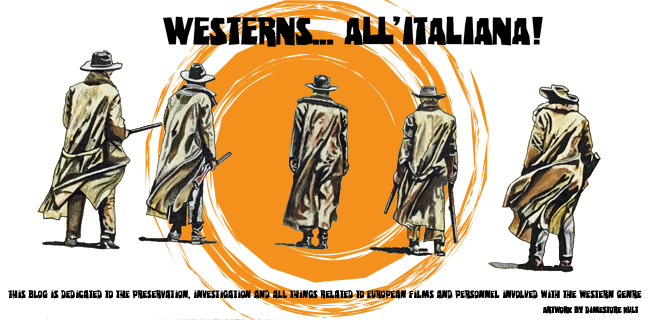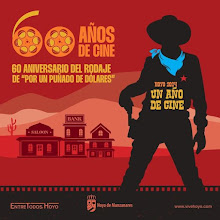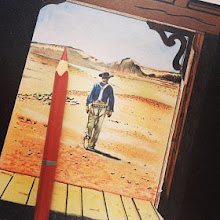CINEMA RETRO SPECIAL REPORT- "VIVA SABATA!":
REFLECTIONS ON THE LEE VAN CLEEF/YUL BRYNNER TRILOGY
By Fred Blosser
On a windy night, a black-clad stranger rides into
Daugherty City, Texas. He flips a coin to a scruffy drunk who is strapped for
the price of a drink. He exposes a crooked dice game in the local saloon, where
most of the townsfolk seem to be congregated. Then he departs. In the meantime,
down the street, a gang of acrobatic robbers breaks into the bank and heists a
safe containing $100,000 in Army payroll money. The getaway crew escapes town
before a wounded trooper can raise the alarm, but out on the trail they run
into the stranger, Sabata, who picks them off with a tricked-out rifle and
recovers the stolen money.
Thus, in under 15 minutes of running time, Gianfranco
Parolini neatly sets up the events that will drive the remaining 90 minutes of
his 1969 Spaghetti Western, "Ehi amico... c'è Sabata, hai chiuso!" --
better known simply as “Sabata,” as United Artists retitled the English-dubbed
version that debuted in the U.S. in 1970. The original Italian title translates
to something like, “Hey, Pal, Sabata’s Here, You Lose” . . . or maybe closer to
the film’s rambunctious spirit, “. . . You’re Screwed.”
Bracketing the opening credits, Parolini economically
introduces most of the movie’s main characters, establishes their
personalities, and through their interactions with Sabata and each other,
defines the interpersonal relationships that will drive the plot.
Sabata (Lee Van Cleef), the sharp-eyed “man who knows,”
as the drunk Carrincha (Pedro Sanchez) calls him, deduces that the men behind
the attempted robbery are the local businessman Stengel, his partner Ferguson,
and their crony Judge O’Hara (Gianni Rizzo). He approaches them and demands
$10,000 in hush money. Refusing, Stengel dispatches one assassin after another
to kill him. Stengel’s henchman Slim, a hulking gunman named Sharky, two hit
men dressed like the Earp brothers, and a nervous killer disguised as a
clergyman all try and fail. With each attempt, Sabata raises his price higher
and higher.
An old acquaintance, barroom minstrel Banjo (William
Berger), one of the supporting characters deftly sketched in the opening saloon
scene, ambles in and out from the periphery, toting his own tricked-out weapon,
a carbine hidden under his musical instrument. Sometimes he sides with Sabata
for money, sometimes he works for Stengel; in any event, not to be trusted by
either. He and a greedy saloon girl, Jane, have a sort of romance characterized
by mutual boredom and availability. Carrincha and a mute Indian acrobat, Alley
Cat (Nick Jordan), help Sabata.
Arguably, “Sabata” represented the high tide of Spaghetti
Western popularity in the States in 1970, benefiting from the box-office
success of Sergio Leone’s groundbreaking films and preceding the decline of the
genre as it sputtered toward a slow box-office death in the mid-‘70s. Where
Leone’s movies were generally panned by mainstream U.S. media on their initial
release, but nevertheless attracted a small early following of more progressive
critics, “Sabata” ironically met the opposite reception.
Major outlets like The New York Times gave it good
notices, but the pioneering book-length studies of the genre by Christopher
Frayling and Laurence Staig & Tony Williams were lukewarm. Staig and
Williams dismissed it as “a mixture of gimmickry and borrowed themes.” Citing
Banjo’s hidden carbine, Frayling said that the movie was one of the
“derivatives” inspired by Leone’s scenes in which “guns are fired from
unexpected places.”
Other commentators over the years have noted additional
Leone influences. Before you see Sabata’s face in the opening scenes, Parolini
gives us a shot down the main street of Daugherty City, framed between Sabata’s
boots in close-up -- a favorite Leone visual angle. Paralleling the three lead
characters of “The Good, the Bad, and the Ugly,” Parolini (who also co-scripted
with Renato Izzo) builds the action around an unflappable protagonist, an icy
bad guy, and a talkative, slippery secondary lead. Sabata’s black suit, black
military coat, and fanciful weapons recall Colonel Mortimer’s from Van Cleef’s
break-out Spaghetti role in “For a Few Dollars More.”
The argument that Leone cast a long shadow over
Parolini’s movie is valid as far as it goes, but then Leone cast a long shadow
over all the Italian Westerns that followed after his enormously successful
pictures with Clint Eastwood. If we acknowledge that “Sabata” often follows the
visual and dramatic conventions of Leone’s movies, it’s only fair to Parolini
to note that he also departed from those conventions in ways that other
Spaghetti directors such as Sergio Corbucci, Sergio Sollima, and Luigi Vanzi
generally didn’t.
For example, like John Ford, Leone held a sentimental
reverence for the sanctity of the traditional family; the families in his
movies symbolize social stability. There are no traditional parents and
children in Parolini’s universe, even if a kid’s chorus heard in the movie’s
bouncy title tune suggests there will be. The only offspring and parent in
“Sabata” are Sharky -- a burly, slovenly adult -- and his gray-haired old
virago of a mother, who berates him verbally and physically for not settling a
score with their neighbors the Mallorys. “They stole your woman, didn’t they?”
she shrieks. No, Sharky retorts, “you sold her to the Mallorys.”
Carrincha, who looks a bit like Sharky in girth and
disheveled appearance, laments his life of thirst and poverty: “I curse the
mother who bore me, and my brother, and my whole family.” Almost everything
Carrincha says is prone to exaggeration, so it’s difficult to know whether this
sentiment is real or not. Regardless, it mirrors and reinforces the satiric
relationship between Sharky and his mother, poles away from the traditional
relationships portrayed by Leone and Ford.
Playing with the “trio” aspect of “The Good, the Bad, and
the Ugly,” Parolini assigns the trickster role of “the Ugly” not to the
boisterous Mexican (in name, at least) Carrancha, as Eli Wallach’s Tuco was
“the Ugly” in Leone’s movie, but to the Anglo drifter, Banjo. This way,
Parolini finds not only differences but also similarities between the two
characters, including allusions to a shared history during and after the Civil
War and maybe a shared past outside the law. This gives their relationship an
extra dimension not present in the relationship between the Good and the Ugly
in the Leone movie.
Critics and fans who appreciate “Sabata” on its own terms
usually employ terms like “hectic and chaotic,” and “fun” that’s “not to be
taken too seriously.” The movie hardly lets up for a moment (none of Leone’s
long, measured takes), but a term like “chaotic” can be misleading if you think
it means slipshod. In fact, even though Parolini doesn’t build the movie around
a mystery as Leone does in “For a Few Dollars More” (what do those seemingly
shared flashback memories by Colonel Mortimer and Indio mean?) or around a
character arc as Sollima does in “The Big Gundown” and Corbucci in “The
Mercenary,” “Sabata” has its own ingenious design. Beyond the action, stunts,
and cynical humor, “Sabata” bears repeated viewing to appreciate the two
techniques that Parolini uses to bring unity to the film.
One technique is repetition. Little details that appear
in one scene in the visuals or in the dialogue will unexpectedly and sometimes
subtly reappear later in a different context. Slim’s loaded dice in the opening
saloon scene always come up 7. There are seven men in the getaway crew from the
bank robbery whom Sabata ambushes. When Sabata checks into a hotel in Daugherty
City, Banjo’s squeeze Jane gives him Room 7 -- “next to mine,” she says
suggestively. (Sabata isn’t interested. As Jules Feiffer once observed of Superman,
he is so self-sufficient and self-confident that he doesn’t need to pursue
every woman he encounters, or even to respond to every pass that comes his
way.)
Parolini’s other technique is music. Like Ennio
Morricone’s compositions for Leone, Marcello Giombini’s score is integrated
into “Sabata” as an essential part of Parolini’s fabric. Like Morricone,
Giombini tailors certain musical themes and cues to specific characters in the
story. As John Mansell observes in his liner notes for a 2001 CD soundtrack
edition, Sabata’s theme incorporates “a rather buoyant sounding guitar piece …
interspersed with a solo muted trumpet, occasional harpsichord flourishes plus
the added support of choir, which is carried along on a backing of slightly
upbeat percussion.” Banjo’s theme is a cocky melody plucked on his namesake
instrument, sometimes augmented by jingling bells like those sewn on his
trousers.
But Mansell’s description of Sabata’s theme, while
insightful, fails to note that the theme also incorporates a glissando passage
like the swirling of the wind. Sabata is associated with the wind throughout
the movie. In the first scene, tumbleweeds blow down the street and lamplight
flutters as Sabata rides into Daugherty City. In the closing scene, Parolini
and Sabata use the wind to the same ironic effect that John Huston used it at
the end of “Treasure of Sierra Madre” and Stanley Kubrick in the finale of “The
Killing.” Although Judge O’Hara wonders if Sabata is a government agent, and
Stengel snaps back that “he’s nothing -- just a drifter who’s after our money,”
the man in black perhaps suggests his true elemental nature when he advises
Stengel in one exchange: “Don’t shoot at the wind.”
Parolini and Giombini also take their partnership one
step further than Leone and Morricone did in their collaborations. In
Morricone’s scores, Leone’s primary characters have (in the words of Staig and
Williams) their own “individual musical signatures” -- the template followed by
Parolini with Sabata’s and Banjo’s themes. The difference is that, in
Morricone’s scores, in any one scene where the character either enters or
dominates the action, his theme predominates. Parolini combines his individual
themes for Sabata and Banjo as point and counterpoint in the same scene to
underscore the two gunmen’s shared history and one-up rivalry.
Banjo’s theme sounds a little like the old military
marching tune, “The British Grenadier,” a reminder of Banjo’s allusion to his
and Sabata’s Civil War past on different sides of the conflict: “You in the
North and me in the South.” In their first meeting after Sabata’s arrival in
town, Banjo plays a mocking version of the tune, in increasingly frantic tempo,
as if trying to get under the other man’s skin. Sabata stops the performance by
shooting one of the pegs off the banjo. “You were out of tempo,” he says dryly.
Near the end of the film, as Banjo leaves Daugherty City
in apparent triumph after a pivotal final encounter with Sabata, a merry
version of his banjo theme begins to play, bolstered by a fife and drum that
underlines the similarity to military marching music. The jingle of bells joins
in with a close-up of the bells on Banjo’s trousers. The viewer senses that
this is the victorious music that Banjo probably hears in his own imagination. However,
Sabata’s wind-theme presently swirls in. As if in competition, the strum of the
banjo gains tempo, becoming increasingly insistent. Remembering the association
of the fast-tempo strumming with the much earlier scene in which Banjo was
humiliated, you may anticipate that Banjo’s present victory will be
short-lived, too.
There isn’t an official 45th anniversary edition of
“Sabata,” but the Swiss label Explosive Media recently released a new Blu-Ray
combo pack that also includes a DVD print, a supplemental disc of interviews
and features, and a nice souvenir booklet in German, copiously illustrated with
stills and pictures of various international posters.
“Sabata” and the two Parolini films that immediately
followed it are popularly known as “The Sabata Trilogy,” although only one is a
true sequel. “Indio Black, sai che ti dico: Sei un gran figlio di . . .,”
released in Italy in 1970, was imported to the U.S. the following year as
“Adios, Sabata.” Yul Brynner played the hero who wears black, this time a black
fringed shirt and bell-bottom trousers instead of Lee Van Cleef’s more formal
outfit. In the Italian version, he’s Indio Black; in the dubbed U.S. print,
Sabata.
Both movies are strongly linked in casting and style.
Three of the major supporting roles in the two movies are occupied by the same
actors (Jordan, Rizzo, Sanchez) and fulfill similar functions in character and
plot. Dean Reed, who looks like the young Roger Moore, plays an opportunist
named Ballantine who serves as this film’s surrogate for Banjo. There are
several big-action set pieces, mostly involving Sabata’s mission in Mexico to
relieve a tyrannical officer, Colonel Skimmel, of a hoard of gold during the
revolution against Maximilian.
“Adios, Sabata” is an entertaining Spaghetti with a
bigger cast of extras and more explosions than its predecessors. One set piece,
in which Sabata sends the no-good Murdock Brothers to their “just reward” in a
showdown at the Bounty Hunters’ Agency, is particularly well dialogued and
choreographed.
But “Sabata” is the better movie, partly because Van
Cleef and Berger had stronger chemistry than Brynner and Reed, and partly
because Brynner’s character is a more traditional soldier of fortune and
do-gooder (he’s friends with benevolent old priests and small children) than
Van Cleef’s enigmatic loner. Although Bruno Nicolai’s score for “Alias Sabata”
is quite good on its own terms, the title track emulating the full-on symphonic,
choral sound of Morricone’s Spaghetti music, it isn’t as ingeniously integrated
into the movie as Giombini’s composition was.
Parolini’s authentic sequel to “Sabata,” released in
Italy in 1971 as "È tornato Sabata... hai chiuso un'altra volta,"
reached the States in 1972 as “Return of Sabata.” Lee Van Cleef returns as the
lead character, and Giombini returns as the soundtrack composer, but
unfortunately this movie doesn’t measure up to its predecessors.
As in “Sabata,”Van Cleef’s character rides into a town
where a cabal of seemingly respectable citizens is engaged in nefarious
activity. This time, the heavies are the outwardly pious McIntocks who trumpet
civic expansion in Hobsonville by raising money for new buildings and
businesses. They do so by imposing exorbitant taxes on the town’s goods and
services.
In truth, patriarch Joe McIntock is conniving with his
brother-in-law, banker Jeremy Sweeney, to smuggle the money out of town for his
own enrichment. Sabata, who arrives in Hobsonville as a sharpshooter in a
traveling circus sideshow, following a hunch about something being rotten
somewhere, uncovers the fraud. As in “Sabata,” he demands blackmail from the
bad guys in return for keeping their secret. The McIntocks, reluctant to pay,
send a series of would-be assassins after him.
Again, Parolini employs his stock troupe of Jordan,
Rizzo, and Sanchez in supporting roles, and inserts a slippery intermediary
character, Clyde (Reiner Schone). Clyde, like Banjo, shares a Civil War past
with Sabata. Giombini’s music isn’t as ingenious as his score for the first
movie, and the circus aspect of the story never quite jells with the plot about
the McIntocks’ scam; as a whole, the movie lacks the little visual and aural
details that wove “Sabata” together.
Another problem: Sabata loses much of the steely,
enigmatic quality that defined his personality in the first movie. In “Return
of Sabata,” an old girlfriend, a hooker named Maggie, drifts into town, and
Sabata shacks up with her. Maggie is never quite integrated into the story
either. Sabata as a mysterious loner in the original film was intriguing. As a
more conventional character with a sexy main squeeze, like a hero out of a
paperback adult western, he isn’t. Still, “Return of Sabata” hardly merits a
place among the “50 Worst Movies of All Time,” as the Medved brothers asserted
in their 1978 book. Maybe Parolini has the last laugh: the Sabata movies live
on while the Medved book is long forgotten.




















No comments:
Post a Comment